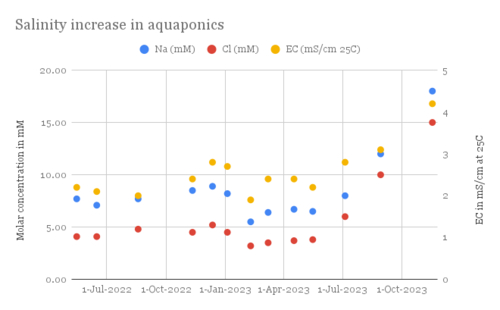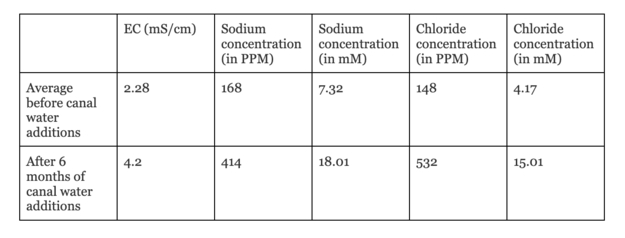As expected, the EC, as well as the sodium and the chloride concentrations have clearly risen since may.
Before we started adding canal water to aquaponics, the EC of the aquaponics water fluctuated around 2-3 mS/cm. This water is already classified as brackish. However, this relatively high salinity was mainly caused by the presence of ‘good’ salts like potassium and phosphate and not because of ‘harmful’ salts like sodium and chloride.
In 6 months we added 7500L of canal water with an average EC of 3.52 mS/cm. The salts that are present in this brackish canal water accumulate in our aquaponics system and because of this we are now approaching an EC of 5 mS/cm in the aquaponics greenhouse. This water is classified as ‘Moderately Saline’. Eventually this will affect the health of our plants (Read more about that here). At this point we do not see clear signs that our plants are struggling. This is in accordance with de Vos et al. (2016), who state that many crops can deal with salinities up to around 5 mS/cm without a yield loss. However, if the salinity level will increase at the same speed we will most probably see the first effects in the next half year.
From lab tests we also learned that the sodium and chloride concentrations have risen considerably. Before adding canal water, the average sodium concentration was 168PPM and the average chloride concentration was 148 PPM. These concentrations have risen to 414 PPM and 532 PPM respectively. The increase in EC can therefore mainly be attributed to the increase in concentration of these two ions.
The changes in the EC and the concentrations of Cl and Na are summarized in the table and the graph below. In research articles there is no standard unit that is used to talk about salinity. This is why we measure both the EC and the ion concentrations, and show different units. In the graph it is clear that even though the salinity has always fluctuated, there is a clear increase in salinity starting in May 2023.
As already said, there is no reason to worry right now. We do not have to adapt to the changing salinity levels yet. However, de Vos et al (2016) found that many popular crops will have a 10% yield loss at an EC of 6-8 mS/cm, and a 50% yield loss at an EC of 9-12 mS/cm. This means that we can expect negative effects in the coming year. So eventually we may have to say goodbye to a couple of plants in the greenhouse, but we believe it is mostly an opportunity to see which plants can withstand this niche environment.
Conclusion
We see a clear increase in the salinity of the water in our aquaponics system. This increase is caused by the addition of the brackish canal water as irrigation water. At this rate, most plants will show a reduction in growth in a matter of months. Within a year, we will most probably see that some plants we currently have will not be able to survive anymore. To assure a green greenhouse we will introduce more salt tolerant species. For now, we think it is a win that we saved 7500L of water and we are excited to learn which plants will make up our aquaponics landscape of the near future.
Sources
de Vos, A., Bruning, B., van Straten, G., Oosterbaan, R., Rozema, J., & van Bodegom, P. (2016). Crop salt tolerance under controlled field conditions in The Netherlands, based on trials conducted at Salt Farm Texel. Salt Farm Texel.

